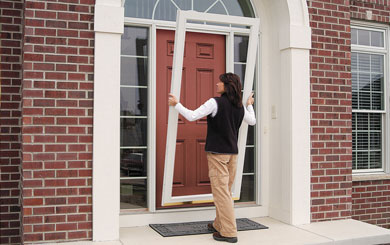 Q: I feel air leaks around my doors, so I’m thinking about adding storm doors. I want ones that also have screens, but my budget is limited. Is it worthwhile adding storm doors, and what should I look for?
Q: I feel air leaks around my doors, so I’m thinking about adding storm doors. I want ones that also have screens, but my budget is limited. Is it worthwhile adding storm doors, and what should I look for?
A: Even though it is a relatively small area compared to the entire wall of a house, just one door can lose a significant amount of energy. Even insulated doors typically have some glass, which have lower insulation value, and inadequate weather stripping will allow air to leak through.
Before buying anything new, make sure your primary doors are as airtight as possible. Adding storm doors can certainly improve the energy efficiency of almost any house, but they are not designed to correct efficiency problems of an old, warped primary door.
If possible, buy replacement weather stripping for your existing doors from the original manufacturer. If you can’t find it, most home improvement stores sell many generic types that should fit. Pry off the old door molding, fill any gaps around the framing with non-expanding foam insulation, and caulk around the door frame.
The quality of the storm door construction is important for a nice appearance, long life, and security. It must withstand a lot of abuse, so it’s best not to pick the cheapest one. From an energy efficiency standpoint, however, the most important factors are the dead air space between the storm and primary doors and how well it blocks the wind.
Buying an aluminum storm door and installing it yourself is the typical low-cost option. They’re very lightweight and made to fit standard-size openings, so installing one is a simple do-it-yourself project.
When you see the door on display attached to a wooden frame at the store, the aluminum frame will feel very strong. When you open the box at home, you may find the unattached aluminum frame strips are somewhat flexible. Be careful not to kink them during handling. Apply a generous bead of caulk on the back of the aluminum frame when screwing it to the door frame.
If you plan to use natural ventilation in the summer, a self-storing triple-track storm/screen door is your most convenient option. The screen panel has its own vertical track in the door, so it never has to be removed. At the end of winter, just slide one of the glass panels down and slide the screen panel up for ventilation.
A fairly new design of storm/screen door uses a spring-mounted roll-up retractable screen that is built into the door. When you’re ready for ventilation, just lower the glass and pull the screen down as far as you wish. This design is attractive because the screen is hidden away during winter without having to remove and store the screen panels.
If your budget allows, some very attractive all-wood framestorm/screen doors (made with mortise and tenon joints) are available. These are strong and secure, but do require some regular maintenance-similar to any wood door. For added security, ornate wrought iron storm doors are available with actual deadbolts and very tough, break-in resistant stainless steel screens.
If your budget is really tight, consider making your own storm door. It is easy to mount hinges in the existing door opening for the storm door. Make a simple wooden frame with only the top half open and a plywood lower panel. This panel improves rigidity for a more airtight seal and better durability.
Most home improvement stores carry sheets of clear acrylic plastic to mount in the frame. Make another narrow wooden frame slightly larger than the open half and mount the acrylic sheet in it. Screw it over the storm door opening. Make a similar frame with screening in it for summer use. If you prefer more durability and efficiency, and a perfectly clear view outdoors is not critical, select double-walled polycarbonate instead of acrylic. You can barely break the polycarbonate, even with a big hammer.
Nail spring-steel weather stripping in the door opening on the latch side, and top and bottom. This type of weather stripping is very durable where there is sliding friction. Adhesive-backed foam weather stripping is effective in compression on the hinge side.
James Dulley is a nationally recognized mechanical engineer writing about home energy issues for the National Rural Electric Cooperaive Association. Send inquiries to James Dulley, Michigan Country Lines, 6906 Royalgreen Dr., Cincinnati, OH 45244 or visit dulley.com.



